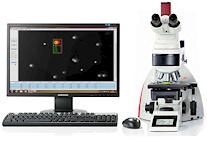High-throughput comet assay
- Details
- Created: Monday, 28 October 2013 16:03
 Researchers in Norway have been taking steps to increase the efficiency and reduce the cost of the comet assay. The researchers believed that the efficiency of the comet assay, in terms of number of samples processed per experiment, was poor. They believed that an improvement to the method would benefit both research and toxicological testing groups.
Researchers in Norway have been taking steps to increase the efficiency and reduce the cost of the comet assay. The researchers believed that the efficiency of the comet assay, in terms of number of samples processed per experiment, was poor. They believed that an improvement to the method would benefit both research and toxicological testing groups.
The researchers designed and validated a method format involving 96 agarose minigels. These minigels are made by applying small droplets of agarose containing cells to a hydrophilic polyester film. Then, using a modified electrophoresis system, the comets were produced. The researchers used “controlled electrophoresis”, which involved circulation of the electrophoresis solution, to improve the homogeneity between replicate samples in the 96-minigel format. The researchers used Comet Assay IV to score the cells within the mingels and concluded that the high-throughput assay gave results that are indistinguishable from the traditional comet assay. Fifty comets were scored per gel. Care was taken to avoid selection bias, that is, overlapping - or potentially overlapping - comets were excluded.
The researchers used Comet Assay IV to score the cells within the mingels and concluded that the high-throughput assay gave results that are indistinguishable from the traditional comet assay. Fifty comets were scored per gel. Care was taken to avoid selection bias, that is, overlapping - or potentially overlapping - comets were excluded.
This high-throughput method allows hundreds of samples to be processed in one experiment by one person, with less time needed for processing, less use of chemicals and requiring fewer cells per sample. It is possible that the high-throughput method described may greatly increase the overall capacity, versatility and robustness of the comet assay. Case study based upon:
Case study based upon:
High-throughput comet assay using 96 minigels Gutzkow KB, Langleite TM, Meier S, Graupner A, Collins AR, Brunborg G. Mutagenesis. 2013 May;28(3):333-40.
Many thanks to Gunnar Brunborg for allowing us to use his images in this case study.
